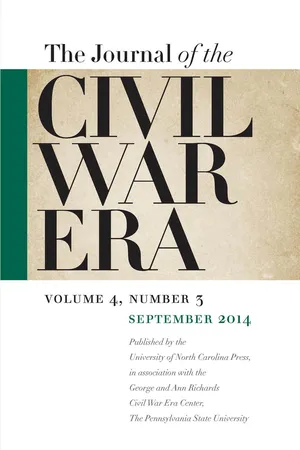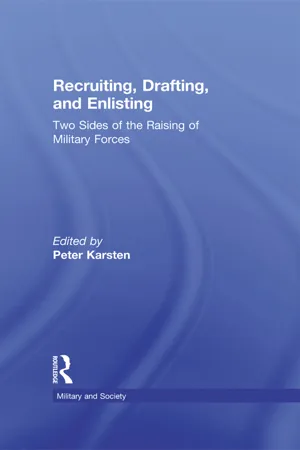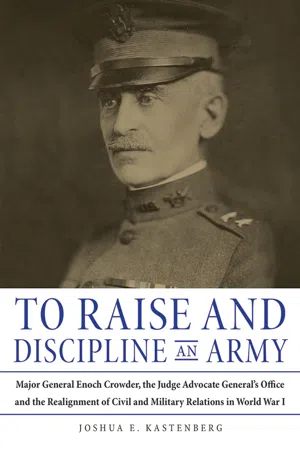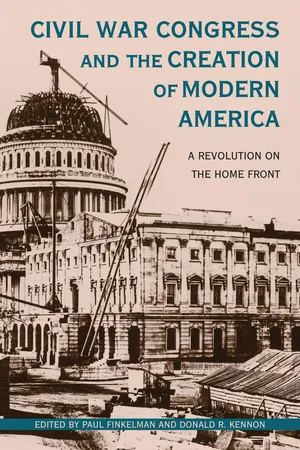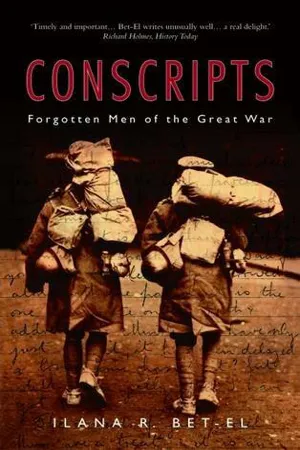History
Conscription Civil War
Conscription during the Civil War refers to the mandatory enlistment of individuals into the military. It was a contentious issue, leading to protests and riots in both the Union and Confederate states. The implementation of conscription laws significantly impacted the war effort and had social and political ramifications that extended beyond the battlefield.
Written by Perlego with AI-assistance
Related key terms
7 Key excerpts on "Conscription Civil War"
- eBook - ePub
Journal of the Civil War Era
Fall 2014 Issue
- William A. Blair(Author)
- 2014(Publication Date)
- The University of North Carolina Press(Publisher)
7Yet this narrative overlooks the attitudes of countless men, like John Harrold, who saw in military service not opportunity but unwanted danger. It overlooks the darker side of citizenship during the Civil War, the stories of men and women who resisted the duties imposed by the nation-state—men and women for whom citizenship was more burden than aspiration. My exploration of the darker side of Civil War citizenship is influenced by such historians as Steven Hahn, Stephanie McCurry, and Gregory Downs, who have recovered alternative political ideals and practices among African Americans and women: ideals and practices that did not fit neatly into the existing framework of liberal citizenship but challenged and sometimes transformed it.8 I also take inspiration from critical scholarship on citizenship throughout American history and in the history of other parts of the world as well. Some of the most insightful studies of U.S. citizenship have emphasized its exclusive as well as its inclusive qualities, its uncertainties and inconsistencies rather than its legal clarity, its repressive as well as its emancipatory potential. Federalism, race, gender—these and other factors have regularly unsettled the purported uniformity of citizenship. The fact that beginning in 1790 naturalization was restricted to those identified as white is a glaring example of this tendency. Rogers Smith, in one particularly influential interpretation, argued that the illiberal, exclusive tendencies of U.S. citizenship were not temporary aberrations but fundamental foundations. Scholarship on citizenship also encourages us to avoid a narrow, legalistic conception of the term and instead approach it as a capacious, fluid concept that was shaped not just by politicians and legal thinkers but also by ordinary men and women, soldiers and civilians, immigrants and the native-born.9 - eBook - ePub
Recruiting, Drafting, and Enlisting
Two Sides of the Raising of Military Forces
- Peter Karsten(Author)
- 2013(Publication Date)
- Routledge(Publisher)
With the American Revolution, the Confederation created a Continental Army by relying on state-provided units and longer enlistment periods. The issue of how best to organize and maintain an effective military was a principal concern for the new, postrevolutionary, property-based democracy. The Constitution of 1789 granted the national government the power to maintain domestic order and to raise an army, but it was silent on means. The Constitution provided for taxation, both national and state roles in developing a military capacity, limited central government, and, most importantly, protection of individual liberties. From its founding (and before), the United States was a country whose citizens generally “did not expect to have their careers interrupted to serve in the army” (Chambers 1987: 28).The changes in the military brought about by the war of 1812 remained the basis for army organization until the Civil War (Skelton 1986). The only major change in the years between 1812 and the Civil War was the abandonment of compulsory military training for the militias of the northern states (Chambers 1987: 36–39). Throughout this whole period, national conscription was politically unacceptable to the populace. Increasingly, at least in the North, even local conscription became untenable, and the old militia began to disappear.The Civil War revealed how unprepared the country was for large-scale warfare.13 The Confederacy, conscious of its relatively fewer numbers and eager to retain the experienced soldiers whose one-year terms were coming due, instituted compulsory military service with the Conscription Act of 16 April 1862. The first act required three years of service. Three years later, service was extended to the duration of the war (ibid.: 45–46).The Union, too, ultimately introduced conscription but only after trying a number of inducement strategies to retain and attract volunteers. Even with conscription, the Union relied primarily on volunteers; the introduction of conscription was more important in inducing volunteerism than it was in its direct production of men. Only about 2% of the Union Army were conscripts and 6% substitutes furnished by those who had been drafted (ibid.: 44). Of those who actually were subjected to the draft, the totals were not much greater: 5% were actually conscripted, 9% furnished substitutes, 12% commuted, and a whopping 41% were exempted (percentages calculated from U.S. War Department 1866: 184–85, 199–200, 211–12). - eBook - ePub
To Raise and Discipline an Army
Major General Enoch Crowder, the Judge Advocate General's Office, and the Realignment of Civil and Military Relations in World War I
- Joshua Kastenberg(Author)
- 2017(Publication Date)
- Northern Illinois University Press(Publisher)
1In 1915 General William Harding Carter analyzed the Civil War conscription experience and concluded that “the failure of execution of the conscription or draft act during the Civil War makes it most unlikely that the principle of compulsory service will ever be acceptable to our people, unless the very existence of the Republican institutions shall be at stake.” Carter, a Civil War, frontier, and Spanish-American War veteran, misjudged the nation’s willingness to conscript its citizens for a foreign war, but clearly the 1863 Draft Riots influenced the military establishment’s strategic thinking in preparing for a pending war in Europe. Crowder believed that conscription was inherently constitutional, but he understood that the Civil War draft, with its multitude of exemptions and payoffs, was not a model for a modern conscription program.2In one respect, the Supreme Court unintentionally made military conscription appear to Crowder to be more likely sustainable against a challenge in federal court. In 1905 the justices decided in Jacobson v. Massachusetts that a state could mandate vaccinations against diseases that had the potential to threaten the health of the state’s population. Placed within the decision is a statement that a citizen could be compelled “to take his place in the ranks of the army of his country, risk the chance of being shot down in its defense.” In 1916 the justices decided in Butler v. Perry that the Thirteenth Amendment, which outlawed peonage and slavery, did not apply to a state’s mandated conscription of civil labor as long as it applied to all males. Like Jacobson, Butler was not a military compulsion case, but Crowder and many preparedness adherents believed it stood for the proposition that citizens could constitutionally be compelled to perform labor for the public good, even if the labor was dangerous.3 - eBook - ePub
Civil War Congress and the Creation of Modern America
A Revolution on the Home Front
- Paul Finkelman, Donald R. Kennon(Authors)
- 2018(Publication Date)
- Ohio University Press(Publisher)
Jennifer L. Weber Conscription and the Consolidation of Federal Power during the Civil WarIN MARCH 1863, an increasingly desperate Union Congress passed a new law called the Enrollment Act to encourage more men to volunteer for military service. In theory, it was a carrot-and-stick sort of arrangement: enlist honorably and receive a healthy incentive for doing so, or undergo the shameful act of being drafted and pass on any bonus. In practice, the arrangement was more complicated because of the various legal options it provided for men to avoid service altogether. And, as it turned out, the law had far-reaching consequences for Americans. The bland legal language of the Enrollment Act belied the changes that it set in motion, changes that resulted in a tectonic shift in the relationship between federal and state governments and between the nation and its people. The transformation that Americans experienced as a result of the draft act fell into three categories: who would raise troops, the degree to which federal government could use coercion, and the ability of the federal government to gather and keep information on its citizenry.1The United States Army had a mere 16,000 members as of 1860, and they were spread widely across the West. About a third of the officers, along with a handful of enlisted men, resigned to join the Confederacy. Clearly, the Union army did not have the manpower to bring the rebels in line. The day after the Confederates took Fort Sumter, President Abraham Lincoln issued a proclamation asking for 75,000 militiamen to suppress them. In the early days of the conflict, war fever gripped the North, and so many men volunteered that the states in charge of enlisting them turned them away. Rebels and Yankees alike predicted the war would last a mere ninety days. South Carolina Senator James Chesnut had offered to drink all the blood that would be spilled, and Southerners assured each other that “a lady’s thimble will hold all the blood that will be shed.” In the North, loyal men continued to step forward enthusiastically well after ninety days had come and gone. For the next year or so, volunteers—the term “militiaman” had been rapidly replaced—were rewarded for their efforts with a hundred-dollar bounty payable upon their being mustered out at the end of their three-year term. Northern recruitment efforts hummed along until the spring of 1862, when enlistments started to drop off.2 - eBook - ePub
Conscripts
Forgotten Men of the Great War
- Ilana R Bet-El(Author)
- 2009(Publication Date)
- The History Press(Publisher)
6 But the force of events quickly made its impact upon policy-makers, and in turn upon the nation. Faced with the reality of a full continental commitment, a call went out for volunteers, with a massive response that yielded an impressive army of over two million men up to January 1916. Yet this endeavour was still undertaken within the pre-war concept of Britain’s role in the war, with the government constantly attempting to balance the national military commitment against the limited ‘business as usual’ principle. It was only when this balance became impossible to maintain – in other words, when it was clear that a viable military commitment could only be sustained with the backing of a full economic commitment – that universal compulsory service was enforced. In other words, conscription actually signified Britain’s final departure from its concept of magnificent isolation and minimal participation in the continental war.Upon this international background, and the raising of a volunteer army, it may be assumed that the introduction of conscription in the midst of the war was a sudden departure within Britain. But that was far from the case. The wider cultural context is explained in the Epilogue, but it is important to emphasise that the issue was already placed on the political and public agenda in 1901, because of the Boer War. For despite an eventual victory, the army at that time displayed severe shortcomings that amounted to a military failure. Both within and outside Parliament voices were raised in demand for a thorough reform of the military forces, a task undertaken in a series of measures by R.B. Haldane, Secretary of State for War between 1905 and 1912. Throughout this period the option of compulsory service was raised several times, but never too forcefully, and this for two major reasons. The first was financial: a national service scheme of any kind would have meant a huge increase in the army budget, and therefore an unacceptable drain upon the capitalist–mercantile economy of turn-of-the-century Britain. The second was conceptual, in that conscription was viewed as an infringement of individual civil rights, and a significant break with centuries of a tradition of volunteering – as well as a decisive step towards Germanic culture and militarism. However, this objection to compulsion was hollow, since forms of militarism – from membership in the Volunteer Force to various elements of Anglican and Nonconformist Christianity – were widely spread throughout Edwardian society. In other words, British militarism existed, but not as an organised political or state endeavour which could be equated with Prussianism.7In the light of these obstacles, any pre-war debate on national service was doomed to failure. Yet there were debates, and they were persistent. In the political arena, the predominantly Tory pro-conscriptionist lobby slowly gained adherents, but the majority of MPs still felt the British public rejected the concept. Their hesitation was compounded by reticence in the higher echelons of the army, who never openly requested compulsion as a matter of military necessity or planning, and therefore a national question that could sway politicians. This also influenced the debate outside Parliament, which was dominated by the activities of the National Service League. Founded in 1902 in order to create a popular basis for its namesake, and headed by the ageing but universally admired war hero Lord Roberts, the League never gained massive support since its appeal was intrinsically to the upper classes of society. However, by August 1914 it had an estimated membership of 250,000 and a significant network of branches; it also boasted the support of well-known Tory figures, and its own journal, A Nation in Arms (previously the National Service Journal).8 - eBook - ePub
- Robert H. Bates, Avner Greif, Margaret Levi, Jean-Laurent Rosenthal, Barry R. Weingast(Authors)
- 2020(Publication Date)
- Princeton University Press(Publisher)
Three Conscription: The Price of Citizenship MARGARET LEVI We’re coming, ancient Abraham, several hundred strong We hadn’t no 300 dollars and so we come along We hadn’t no rich parents to pony up the tin So we went unto the provost and there were mustered in. Sandburg 1948:2:362THROUGHOUT the nineteenth century states enhanced the extent and depth of their administrative and coercive capacity while also expanding the privileges and numbers of their citizens. Rulers developed increasingly efficient and centralized administrative apparatuses to monitor and extract manpower from the countryside, but they had to appease citizens who were also voters and to ensure the cooperation (or at least avoid the resistance) of those whose services they sought, whether or not they were voters. Consequently, nearly all the European, North American, and antipodean states—democratic or autocratic— redefined the mutual obligations of citizens and government actors.The substantive focus of this chapter is on the disappearance of various forms of buying one’s way out of military service if conscripted: commutation (a fee paid to government) and substitution and replacement (payment to someone else to take one’s place). “Buying out” had its origins in the feudal obligations of subjects to their lord; feudal subjects had the option of paying a fee in lieu of military service. The nineteenth-century defense of medieval practices led to a series of rationales, but all were based on distinctions among classes. Buying out, advocates claimed, protected the sons of the well-off from the greater suffering and costs military service would impose on them than on those more used to the rough life. Furthermore, they pointed to the benefits to society of a system in which those who could serve the country better in other occupations were permitted to do so while also contributing to the government’s coffers or to a poorer person’s pocketbook. - eBook - ePub
Abraham Lincoln
A Biography
- Lord Charnwood(Author)
- 2017(Publication Date)
- Samaira Book Publishers(Publisher)
Events conspired to make the mistake disastrous. In these very days the Confederacy was about to pass its own Conscription Act. McClellan, instead of pressing on to Richmond, sat down before Yorktown and let the Confederate conscripts come up. Halleck was crawling southward, when a rapid advance might have robbed the South of a large recruiting area. The reopening of enlistment came on the top of the huge disappointment at McClellan’s failure in the peninsula. There was a creditable response to the call which was then made for volunteers. But the disappointment of the war continued throughout 1862; the second Bull Run; the inconclusive sequel to Antietam; Fredericksburg; and, side by side with these events, the long-drawn failure of Buell’s and Rosecrans’ operations. The spirit of voluntary service seems to have revived vigorously enough wherever and whenever the danger of Southern invasion became pressing, but under this protracted depressing influence it no longer rose to the task of subduing the South. It must be added that wages in civil employment were very high. Lincoln, it is evident, felt this apparent failure of patriotism sadly, but in calm retrospect it cannot seem surprising. In the latter part of 1862 attempts were made to use the powers of compulsion which the several States possessed, under the antiquated laws as to militia which existed in all of them, in order to supplement recruiting. The number of men raised for short periods in this way is so small that the description of the Northern armies at this time as purely volunteer armies hardly needs qualification. It would probably be worth no one’s while to investigate the makeshift system with which the government, very properly, then tried to help itself out; for it speedily and completely failed. The Conscription Act, which became law on March 3, 1863, set up for the first time an organisation for recruiting which covered the whole country but was under the complete control of the Federal government
Learn about this page
Index pages curate the most relevant extracts from our library of academic textbooks. They’ve been created using an in-house natural language model (NLM), each adding context and meaning to key research topics.
